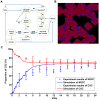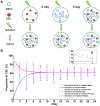Dynamics between cancer cell subpopulations reveals a model coordinating with both hierarchical and stochastic concepts
- PMID: 24416258
- PMCID: PMC3886990
- DOI: 10.1371/journal.pone.0084654
Dynamics between cancer cell subpopulations reveals a model coordinating with both hierarchical and stochastic concepts
Abstract
Tumors are often heterogeneous in which tumor cells of different phenotypes have distinct properties. For scientific and clinical interests, it is of fundamental importance to understand their properties and the dynamic variations among different phenotypes, specifically under radio- and/or chemo-therapy. Currently there are two controversial models describing tumor heterogeneity, the cancer stem cell (CSC) model and the stochastic model. To clarify the controversy, we measured probabilities of different division types and transitions of cells via in situ immunofluorescence. Based on the experiment data, we constructed a model that combines the CSC with the stochastic concepts, showing the existence of both distinctive CSC subpopulations and the stochastic transitions from NSCCs to CSCs. The results showed that the dynamic variations between CSCs and non-stem cancer cells (NSCCs) can be simulated with the model. Further studies also showed that the model can be used to describe the dynamics of the two subpopulations after radiation treatment. More importantly, analysis demonstrated that the experimental detectable equilibrium CSC proportion can be achieved only when the stochastic transitions from NSCCs to CSCs occur, indicating that tumor heterogeneity may exist in a model coordinating with both the CSC and the stochastic concepts. The mathematic model based on experimental parameters may contribute to a better understanding of the tumor heterogeneity, and provide references on the dynamics of CSC subpopulation during radiotherapy.
Conflict of interest statement
Figures





References
-
- Dick JE (2008) Stem cell concepts renew cancer research. Blood 112: 4793–4807. - PubMed
-
- Shackleton M, Quintana E, Fearon ER, Morrison SJ (2009) Heterogeneity in Cancer: Cancer Stem Cells versus Clonal Evolution. Cell 138: 822–829. - PubMed
-
- Baker M (2012) Cancer stem cells tracked. Nature 488: 13–14. - PubMed
Publication types
MeSH terms
LinkOut - more resources
Full Text Sources
Other Literature Sources

